DEVELOPMENT OF SURGICAL INSTRUMENTS
Making Ophthalmic Surgeries Smarter!
We are developing ophthalmic surgical instruments with the concept of swift and safer surgeries. The three products shown below are currently available in Japan.
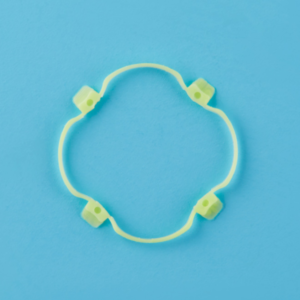
Clover-Ring
A clover-shaped pupil dilator designed for quick and safe placement.

Germ-Guard film drape
A pre-cut, drainable drape for quick and safe surgery.
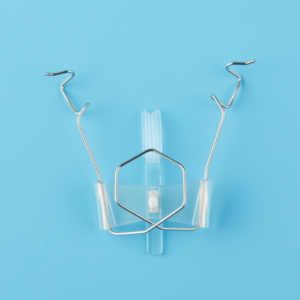
Smart-Spec
A speculum with a wing-like motion for effortless and damageless eye opening.
Development of Pupil Dilators
■Current Issues With Conventional Pupil Dilators
Background and Conventional Pupil Dilators
In cases where the pupil does not dilate sufficiently with a mydriatic agent, alternative techniques such as making multiple radial incisions at the pupillary margin or performing a large incision followed by suturing have been employed. However, these are time-consuming and invasive procedures.
To address this issue, the iris retractor was developed. In this technique, four small incisions are made in the cornea, allowing insertion of the iris retractor. Once inserted, the hook at the tip of the retractor is placed on the edge of the pupil, and the device is pulled toward the incision. A silicone stopper is then pressed against the cornea to secure the retractor. This method, however, is labour-intensive and time-consuming. Additionally, because the hook is made of thin resin wire, there is a risk of tearing the pupillary margin during expansion, potentially resulting in postoperative pupil deformation.
Various ring-shaped pupil dilators have been developed to simplify and expedite pupil dilation. These devices are typically square or circular. They are folded and inserted into the eye using a special injector, where they expand the pupil by hooking onto the pupil margin through grooves in the ring.
Conventional Pupil Dilators

a. Iris retractor (four required)
b. Wire-shaped ring pupil dilator
c. Band-shaped ring pupil dilator
Placement of conventional Pupil Dilators

However, these pupil dilators are made of a material with high shape memory, which resists deformation. Once released into the eye from the injector, they return to their original ring-shaped diameter of about 6 to 9 mm. When positioning the dilator onto the pupil, the product must be moved across a wide area while maintaining its fully expanded shape. This can stretch and compress the iris, potentially causing damage to the iris tissue.
Additionally, placing these dilators is particularly challenging for small pupils with a diameter of 3 mm or less.
■Solution with Mirai Eye’s Pupil Dilator
Structure of the Clover-Ring


- The Clover-Ring is made of polyurethane and consists of a circular arm with four iris hooks.
- Viewed from above, the arm that bulges outward and the arm that concaves inward are arranged alternately. The iris hooks are positioned at the center of the arm that concave inward.
- The diameter across the convex sections is 8.2 mm, while the diameter across the concave sections is 6.2 mm.
- From a side view, the iris hooks are located at a lower position relative to the arm. The arm shoulder are situated at higher position, while the center of the arm that bulge outward are situated at lower position.
- The height difference between the lowest position of the protrusion below iris hook and the highest position of the arm shoulder is 0.72 mm.
Feature of the Clover-Ring
〈Feature1〉
Four-leaf clover shape
The arm features alternating the parts that bulge outward and the parts that concave inward with the iris hooks located in the parts concave inward. This design allows the arm to deform easily, making it easier to move the iris hook inward.
〈Feature2〉
Placing the iris hooks while keeping the arm on the iris
The arm remains positioned on the iris while the iris hooks are moved inward. The pupil is dilated by inserting the lower projections of the iris hooks beneath the iris.
The Clover-Ring can be positioned without significantly deforming the pupil due to its unique shape and movement.
Additionally, the Clover-Ring securely fixes the iris by holding it between the arm and the lower projections of the iris hook.
〈Feature3〉
Insertion and removal using forceps
The Clover-Ring can be inserted and removed using capsule forceps, eliminating the need for an inserter.
It can be reused up to three times, including the first use.
Insertion of the Clover-Ring using Forceps

Lay the capsular forceps on their side, grasp the arm shoulder from above and below, and insert the Clover-Ring into the anterior chamber through the main incision.
When two or three iris hook are inside the anterior chamber, slightly open the forceps to release the Clover-Ring, and then withdraw the forceps.

Using capsular forceps, grasp the arm that are still outside the eye, and gently insert the remaining iris hook and the arm into the anterior chamber.
<Tips for Operation>
- Micro capsular forceps offer an advantage over conventional capsular forceps as they help maintain the integrity of the wound.
- Injecting Viscoat™ near the wound after administering the usual viscoelastic is beneficial because it reduces leakage of viscoelastic.
<Important notices>
- When using standard capsule forceps, avoid using forceps with weak spring action for opening. The forceps with weak spring power don’t open fully within the wound, preventing the proper release of the Clover-Ring.
- Do not grasp the centre of the arm, as doing so will cause two iris hooks to approach the wound simultaneously, making it difficult to insert the Clover-Ring.
- Be sure not to confuse the front and back of the Clover-Ring. The holes in the iris hooks should be visible from the front side.
- A 2.0 mm or larger incision is required when using microcapsular forceps. An incision of 2.2 mm or larger is necessary for standard capsular forceps.
Placement of the Clover-Ring using a Sinskey hook
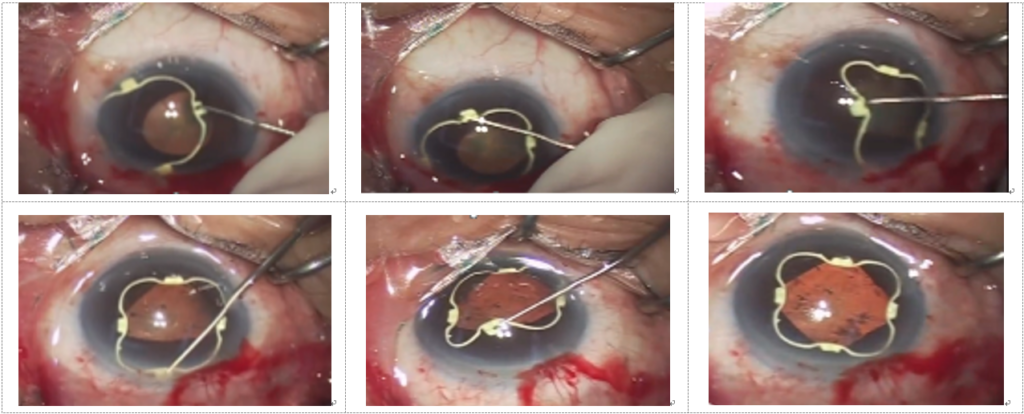
Insert a Sinskey hook into the anterior chamber from the side port or the wound and engage the hole of one of the in hook (either by catching the outer wall of the iris hook or the neck of the arm). While keeping the arm positioned on the iris, move the iris hook inward. Next, insert the lower projection of the iris hook under the iris, and gently move the iris hook outward to expand the pupil.
<Tips for operation>
- Instead of a Sinsky hook, you can use a push & pull hook and move in is hook by catching the outer wall of the iris hook or the neck of the arm.
- The overall procedure becomes smoother, if you move iris hook currently being catched outward so that the iris hook to be catched nextly move inward.
<Important notice>
- The Clover-Ring typically achieves a pupil diameter of 6 to 6.5 mm. In rare cases, the pupil may not enlarge sufficiently due to sclerosis of the iris tissue, which is more likely in cases where the pupil diameter is less than 3 mm and the iris has significant pseudoexfoliation. In such instances, you can expand the pupil by moving two iris hooks diagonally across the pupil using two Sinskey hooks to stretch the iris tissue. Alternatively, the pupil can be further enlarged by making two to four small radial incisions at the pupillary margin.
Retrieval of the Clover-Ring using Forceps
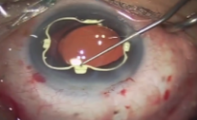
Insert a Sinskey hook from the side port or the wound and release the two iris hooks near the wound from the pupillary margin.
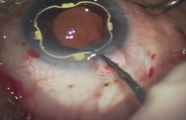

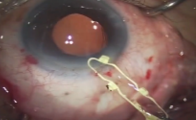
Lay the forceps on their side and insert them through the wound. Grasp the arm shoulder near the wound from both above and below, then carefully withdraw the Clover-Ring from the eye.
<Tips for Operation>
- Injecting Viscoat™ near the wound after administering standard viscoelastic is advantageous compared to using only the usual viscoelastic. This method reduces viscoelastic leakage and lowers the risk of iris prolapse.
- When releasing the two iris hook parts near the wound from the pupil using a Sinskey hook, push the ring inward and lift it from the iris. This ensures smoother handling when grasping the arm near the wound.
- Instead of a Sinsky hook, you can use a push & pull hook to release the iris hook from the pupil.
<Important notices>
- Do not grasp the centre of the arm. If you do, two iris hook will approach the wound at the same time and will not be able to pass through. In such a case, you can reposition the ring by pushing it back into the anterior chamber, then grasp the shoulder of the arm to pull it out properly.
DEVELOPMENT OF THE EYEDRAPE
■Issues with Conventional Eye Drapes
Background
In ophthalmic surgeries, such as cataract surgery, the primary goal is to ensure a safe surgery without complications. To achieve this, proper draping and effective drainage are crucial. Proper draping prevents the exposure of eyelashes and skin to the surgical field, thereby minimizing the risk of introduction into the eye through surgical instruments. This significantly reduces the risk of postoperative endophthalmitis. With the rise of drug-resistant bacteria like MRSA, preventing postoperative bacterial endophthalmitis, which can lead to blindness, remains a major challenge for ophthalmic medical professionals.
Effective drainage improves visibility during surgery and reduces the risk of intraoperative complications. Additionally, it expels bacteria present in accumulated fluid from the eye, further lowering the risk of postoperative endophthalmitis.
Conventional Eye Drapes and Competing Products
The conventional method of draping involves cutting a film drape (a) in half and attaching each half to the upper and lower eyelids. However, the ear and nose sides of the eyelashes and eyelids are often left uncovered and exposed. When a film drape is attached as a single piece and then cut with scissors, it is easy to cover the entire eyelid and eyelashes, but the lateral canthus of the eye becomes tent-shaped and water tends to accumulate. In an attempt to solve this problem, the tent-shaped film part is cut, exposing the skin of the
lateral canthus .
To solve this problem, a disposable drapes with eyelid opening feature (c) was developed that covers the entire eyelid, but it did not become popular because water tends to accumulate. In addition, a disposable eyelid retractor with a wide hook (b) for intravitreal injection is on the market, but the skin on the ear and nose sides other than the upper and lower eyelids remains exposed.
Conventional Eye Drapes and Competing Products

Conventional Drainage Instruments
Traditionally, to drain the surgical field, retractors with suction holes that have a pump function to suck water into the retractor, and drainage devices that are hooked onto the eyelid on the ear side and drain using capillary action, etc., have been used. However, these are expensive and sometimes do not provide sufficient drainage function in cases where the eyes are deeply recessed or the conjunctiva is loose.
Conventional eyelid retractor and drainage devices that drain fluids during surgery

■Solution with MIRAI EYE’s Eye Drape
Structure of the Germ Guard Film Drape
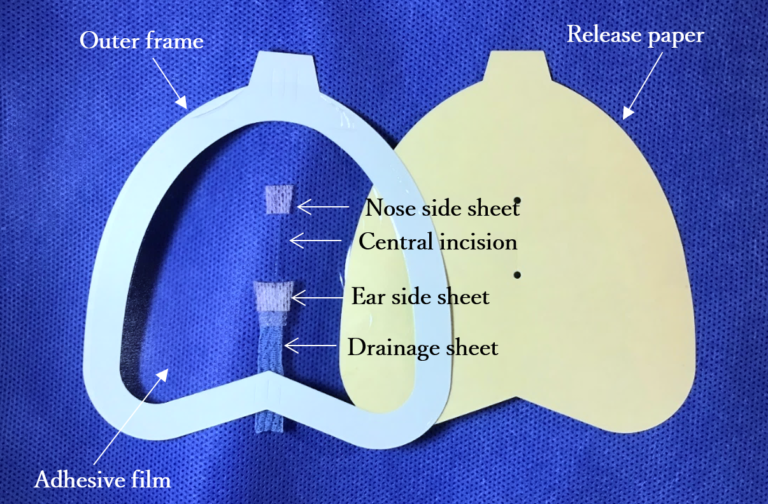
Germ Guard film drapes are constructed with an outer frame and an adhesive film section, and there is a central incision in the center of the adhesive film section.
On either side of the central incision, there are the ear side sheet and the nose side sheet that cover the outer and inner canthus of the eye, and there is also a drainage sheet on the ear side.
Features of the Germ Guard Film Drape
〈Feature1〉
Central Incision
An incision is pre-made in the centre of the film, eliminating the need to cut the film before or after application.
〈Feature2〉
Ear and Nose Side Sheets
The drape includes sheets to cover the ear and nose sides of the eyelid. When the central incision is opened with a speculum, a nonwoven sheet covers the ear and nose sides of the eyes and eyelashes.
〈Feature3〉
Drainage Sheet
A sheet made of woven nylon fibres is placed on the ear side of the central incision, which drains fluids through capillary action.
Due to these characteristics, Germ-Guard film drapes are expected to shorten surgery time, improve visibility during the procedure, and reduce the risk of postoperative endophthalmitis.
Placement of the Germ Guard Film Drapes
<Placement with the Assistance from an Assistant>
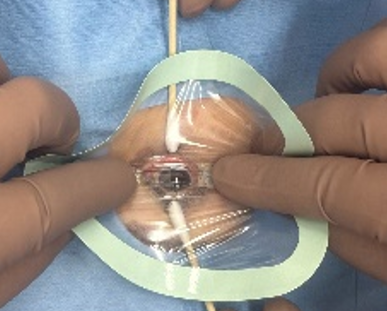
The surgeon removes the release paper and folds both ends of the drape outer frame to make the entire drape into a V shape. Then, hold both ends of the drape with three fingers (index finger on top of the film and other fingers under the outer frame). The assistant uses cotton swabs in both hands to open the upper and lower eyelids.
The surgeon attaches the bottom of the V-shaped on the line where the central incision passes through the inner and outer canthus of the eye, in a position where the outer canthus is covered by the ear side sheet.

While the surgeon maintains the V shape, the assistant removes the cotton swabs. The surgeon attaches the drape toward the outer frame on the upper and lower eyelids, and finally toward the ear.
If the outer frame is raised on the ear side, pinch it with your fingers and fold it over to flatten it.
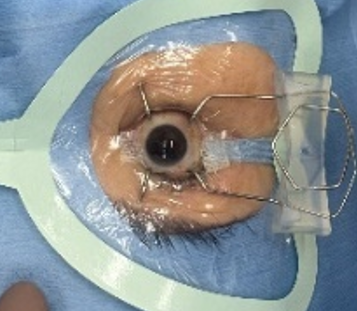
Insert the speculum through the central incision to open it.
When the film is properly positioned, the skin and eyelashes of the upper and lower eyelids are fully wrapped and covered by the film, while the nose and ear sides of the eye are covered by both the film and the respective side sheets. Additionally, the tip of the drainage sheet is positioned downward, extending from the lateral canthus toward the conjunctiva.
<Placement by a Surgeon with no Assistant>
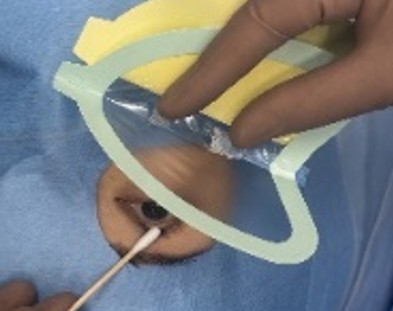
Remove the release paper and fold it in half with the smooth side facing outward. Attach this release paper to the film of adhesive side of the lower eyelid, side ensuring the central incision and each sheet are visible.
Fold both ends of this outer frame to form a V-shape with the central incision at the bottom.
Then, hold the lower eyelid side of the drape, along with the release paper, positioning thumb and index finger at the outer ends of the ear-side and nose-side sheets, respectively.

Use a cotton swab in your other hand to open the upper eyelid.
Attach the film along the line where the central incision passes through the inner and outer canthus, ensuring that the outer canthus is covered by the ear-side sheet.

While pressing the film over the outer and inner canthus with your fingers, remove the cotton swab and apply the film on the upper eyelid side.

Raise the drape on the lower eyelid side to expose the lower eyelid edge. At this point, use a cotton swab to press the skin and detach the film from the lower eyelid.
With a cotton swab in your other hand,open the lower eyelid downward.
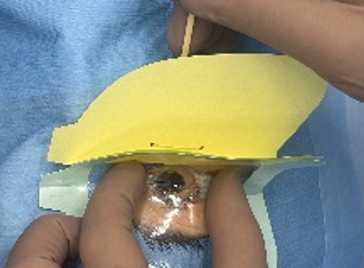
Apply the drape to the outer and inner canthus of the eye, and remove the cotton swab while holding both with fingers. Then Pull the skin side of the folded release paper downward to remove the release paper.
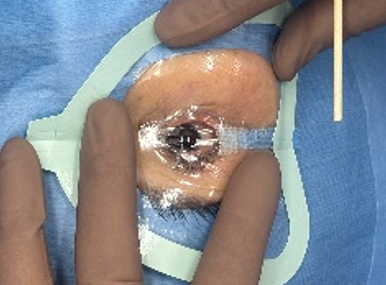
Apply the film on the lower eyelid side.
Finally, secure the film on the ear side.
If the outer frame lifts, pinch it with fingers and fold it over to flatten it on the ear side.
Drainage Effect of the Germ Guard Film Drape
The drainage function of Germ-Guard film drapes was verified using a drainage experiment device. When water was dripped at a constant rate, the Germ-Guard film drapes demonstrated a superior drainage effect, accumulating less water compared to general film drapes or when used with the drainage device “Miracle Drainer.”
During surgery, the water is effectively drained through physical phenomena such as capillary action and the siphoning effect between the drainage sheet of the Germ-Guard film drapes and the irrigation fluid. This prevents water pooling and improves visibility in the surgical field, reducing the risk of intraoperative complications caused by poor visibility. Additionally, bacteria from the eyelid skin and eyelashes are discharged along with the water, which is expected to more effectively reduce the risk of postoperative bacterial endophthalmitis.

a. A significant amount of water was retained with a regular film drape.
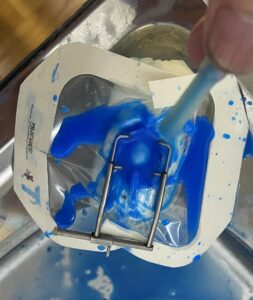
b. Aregular film drape combined with the drainage device (Miracle Drainer) retained less water than a standard film drape alone.

c. The Germ-Guard film drape retained less water than both the regular film drape (a) and the regular film drape with the Miracle Drainer (b).
DEVELOPMENT OF THE EYELID RETRACTOR
■ISSUES with Conventional Eyelid Retractors
Structure and Placement of Conventional Eyelid Retractors
In conventional eyelid retractors, the spring and slide mechanism are positioned parallel to the arm, causing the hook parts to open and close parallel to the eyelid.
As a result, even when the retractor is closed, the distance between the left and right hook parts remains wide, requiring the instrument to be tilted to properly position it on the upper eyelid. The lower eyelid must then be opened with the left hand to set the retractor. This setup can be challenging, especially for deep-set eyes. Additionally, conventional retractors pose a risk of damaging the eyelid tissue, particularly the levator aponeurosis, when opened too widely, potentially leading to postoperative ptosis.
Moreover, in cases of deep-set eyes, lifting the eyelid can accentuate the depth, making it easier for water to pool.
Placement of a conventional eyelid speculum on the eyelid

The spring is attached parallel to the arm.

Tilt the device and point the upper hook part downward. Insert the upper hook part under the upper eyelid.

Open the lower eyelid with fingers, and insert the lower hook part under the lower eyelid.
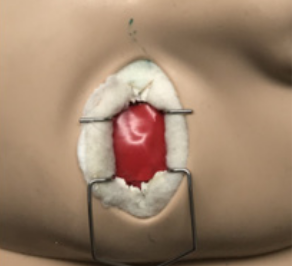
The hook parts open parallel to the eyelids.
Opening and closing of conventional speculum and eyelid tissue condition
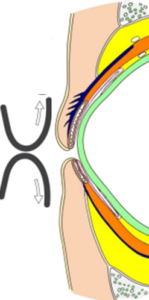
Even when the device is closed, there remains a wide gap between the lower tips of the left and right hooks.

Since the hooks open parallel to one another, the wider they open, the more the eyelids are lifted, causing a sharp bend in the eyelid tissue.
■Solution with MIRAI EYE`s Eyelid Retractor
Structure of the Smart-Spec
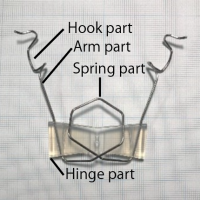
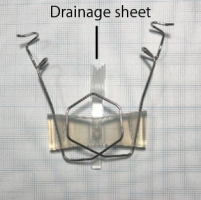
- Smart-Spec consists of a hook, arm and spring made of stainless steel wire, and the bottom end of the arm has a silicone hinge grip.
- Smart-Spec with drainage sheet is equipped with a silicone bellows-structured drainage sheet.
Features of the Smart-Spec
The Smart-Spec is distinguished by its spring being attached perpendicular to the arm. When the hinge grip is closed or opened, the spring moves up and down, causing the hook parts to rotate and move like flapping wings. In other words, when the arm is closed, the left and right hooks tilt downward, narrowing the gap between them (a→b→c).
Conversely, when the arm is opened, the hooks face outward, widening the gap between them (c→b→a).
Opening and closing movement of the Smart-Spec
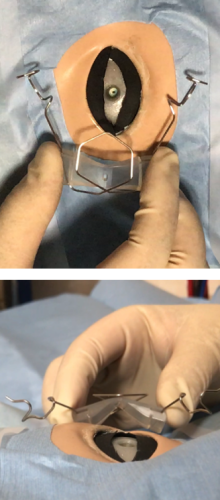
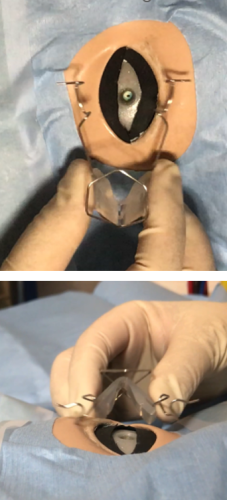
When the hinge grip is closed, shortening the distance between the left and right arms and the hook parts, the spring moves up and down, causing the left and right hooks to rotate and point downward.
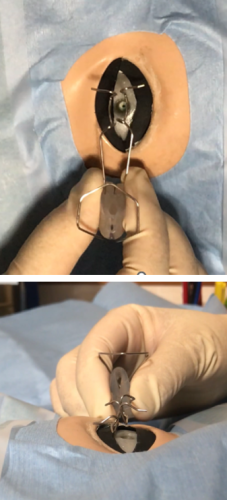
The lower tips of the left and right hook parts point diagonally downward, and the distance between them is narrowed.
Setting and Removing Smart-Spec on Eyelids
With the Smart-Spec, first, close the arm and narrow the gap by pointing the left and right hooks diagonally downward (d). Insert the hooks between the upper and lower eyelids (a), and as you open the arm, guide the hooks downward toward the conjunctival sac to fully open the eyelids (b, c). Once the eyelids are open, the 3D curve of the hook wires closely matches the natural 3D curve of the eyeball and eyelid where it is positioned (e, f).
When setting the Smart-Spec from the head of the patient, use the right hand for the right eye and the left hand for the left eye. If setting from the ear side, use the left hand with support from the right hand. To remove the retractor, reverse the insertion process: close the arm and gently move the retractor upward, guiding the hooks out toward the conjunctival sac (c→b→a).
This design and movement make it relatively easy to install the Smart-Spec, even for patients with deep-set eyes or narrow eyelids. Additionally, the Smart-Spec is designed to open the eyelids gently without creating sharp bends in the eyelid tissue (e). This feature is expected to lower the risk of damaging the levator aponeurosis and reduce the likelihood of postoperative ptosis.
Setting of the Smart-Spec on the eyelid
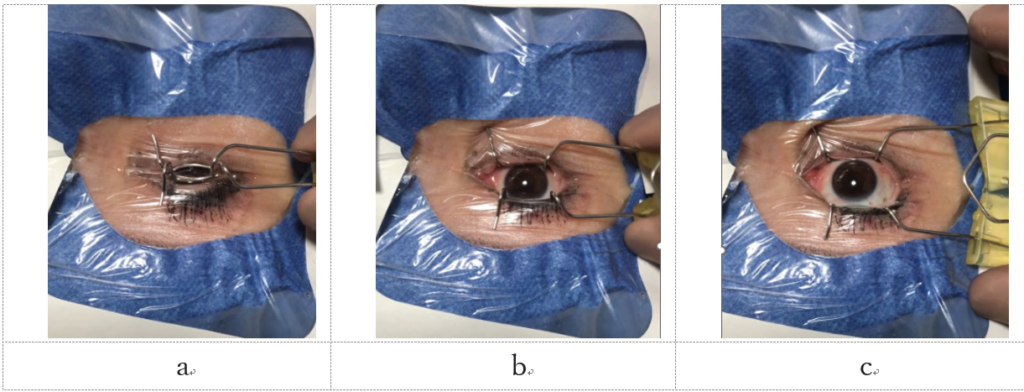
Opening and closing of the Smart-Spec and eyelid tissue condition
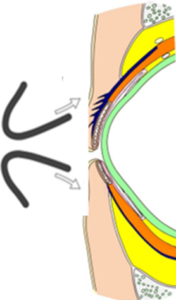
Close the hinge clip, point the lower tips of the left and right hooks diagonally downward, narrow the gap between them, and insert the hooks between the upper and lower eyelids.

Open the hinge clip and move the entire device downward, inserting the hooks toward the conjunctival sac to open the eyelids.
Even when the eyelids are opened widely, they are less likely to lift excessively, making it difficult to create a sharp bend in the eyelid tissue.
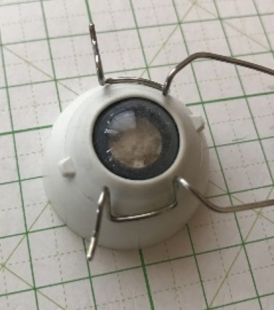
When the eyelids are open, the curve of the hook closely matches the natural curve of the eyeball, minimizing pressure on both the eyelids and the eyeball.
After placing the Smart-Spec with the drainage sheet on the eyelid, in the same manner as the regular Smart-Spec, adjust the position of the drainage sheet so that its tip hangs down from the lateral canthus to the bulbar conjunctiva.
If the tip of the drainage sheet is misaligned front-to-back, slide the hinge grip back and forth with your finger to correct its position (a, d). If the drainage sheet is misaligned left-to-right, rotate the drainage sheet using your finger or a scissor to adjust the position.
Setting Smart-Spec with Drainage Sheet on Eyelid and Aligning the Drainage Sheet
Aligning the Drainage Sheet of the Smart-Spec with the Drainage Sheet
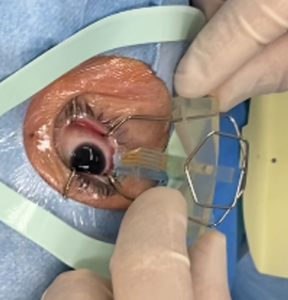
The tip of the drainage sheet is positioned on the ear side of the lateral canthus.

Use your fingers to move the hinge grip toward the nose, ensuring that the tip of the drainage sheet hangs down from the outer canthus onto the conjunctiva.
Drainage experiment of Smart-Spec with drainage sheet
The Smart-Spec’s drainage sheet features a bellows structure that absorbs and drains water through capillary action and the siphoning effect. In our experiment, it demonstrated a superior drainage capacity compared to conventional drainage device, as shown in the figure below.
Additionally, the Smart-Spec with a drainage sheet does not need to be connected to a suction pump, unlike the retractors with suction holes. This also means its drainage effect is not diminished by the suction of the conjunctiva, which may loosen with age.
Verification of drainage effect using experimental equipment

